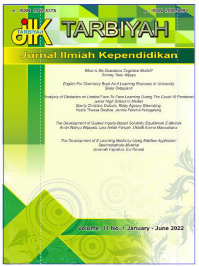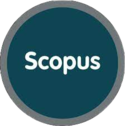Analysis of Obstacles on Limited Face-To-Face Learning During The Covid-19 Pandemic Junior High School In Medan
DOI:
https://doi.org/10.18592/tarbiyah.v11i1.6412Abstract
This study aims to describe the obstacles experienced by students during limited face-to-face learning. By making class VII-8 at Junior High School 27 Medan as a research sample, it will analyze what obstacles are experienced by students. Research method used is descriptive quantitative method. The study used an instrument in the form of a questionnaire that would be given to students directly and provided four answer choices based on a Likert scale and structured interviews. The results of the study, it was found that students experienced problems in implementing limited face-to-face learning in the four aspects, namely in the aspects of facilities and infrastructure to support learning was obtained in the fairly good category, the classroom management aspect obtained the good category, the aspect of student activity get the unfavorable category, the aspect of student understanding gets the poor category, and the aspect of student concentration in doing learning gets a poor category. For this reason, good management is still needed in overcoming several obstacles in the limited face-to-face learning process, all parties, both principals, teachers, students and other school residents must participate in overcoming the obstacles that arise.References
Ananda, R & Banurea, O.K. (2017). Manajemen Sarana Prasarana. Medan: CV. Widya Puspita
Anugrahana, A. (2020). Hambatan, Solusi Dan Harapan: Pembelajaran Daring Selama Masa Pandemi Covid-19 Oleh Guru Sekolah Dasar. Scholaria: Jurnal Pendidikan Dan Kebudayaan. 10(3), 282-289.
Assiddiqi, D. R. & Soeryanto. (2021). Peluang Menurunnya Capaian Hasil Belajar (Learning Loss) Dan Alternatif Solusinya: Kajian Kasus Pembelajaran Online Di Era Pandemi Covid-19 Di Jurusan Teknik Mesin UNESA. JPTM. 10(03), 47-54.
Barus, V. (2021). Efektivitas Pembelajaran Jarak Jauh Terhadap Pembelajaran Matematika Siswa Pada Masa Pandemic Covid-19 Di SMP Budi Murni 2 Medan Tahun Ajaran 2020/2021. Cartesius: Jurnal Pendidikan Matematika. 4(2), 109-119.
Husna, M., & Sugito, S. (2021). Eksplorasi Penerapan Pembelajaran Tatap Muka Terbatas pada Jenjang PAUD di Masa Kebiasaan Baru. Jurnal Obsesi: Jurnal Pendidikan Anak Usia Dini. 6(3), 1846-1858.
Izzah, F. N., Khofshoh, Y. A., Sholilah, Z., Nurningtias, Y., & Wakhidah, N. (2022). Analisis Faktor–Faktor Pemicu Turunnya Keaktifan Siswa Dalam Proses Pembelajaran Mata Pelajaran IPA Di Masa Pandemi. Pensa E-Jurnal : Pendidikan Sains. 10(1), 150-154.
Klassen, R. M., & Chiu, M. M. (2010). Effects on teachers' self-efficacy and job satisfaction: Teacher gender, years of experience, and job stress. Journal of Educational Psychology, 102(3), 741.
Liku, E., Limbong, M., & Tambunan, W. (2021). Analisis Kemampuan Guru Dalam Perencanaan Pembelajaran PPKn Pada Tatap Muka Masa Pandemi Covid-19 di SMPN 2 Rantepao. Jurnal Manajemen Pendidikan. 10(2), 91-99.
Mustakim, U. S., Dewi, R., Mulyasari, A., Juanto, A., & Kamali, A. S. (2021). Efektifitas Pembelajaran Tatap Muka Terbatas di Masa Pandemi Covid-19 (Studi Empiris Terhadap Mahasiswa di STKIP Syekh Manshur). Al-Miskawaih: Jurnal Pendidikan Agama Islam. 2(2), 171-178.
Novitra, F. (2022). Networked-based Inquiry: An Effective Physics Learning in the New Normal COVID-19 Era in Indonesia. International Journal of Instruction, 15(2), 997-1016.
Onde, M. K., Aswat, H., Sari, R. E., & Meliza, N. (2021). Analisis Pelaksanaan Pembelajaran Tatap Muka Terbatas (TMT) di masa New Normal terhadap Hasil Belajar Matematika di Sekolah Dasar. Edukatif : Jurnal Ilmu Pendidikan. 3(6), 4400-4406.
Pattanang. E., Limbong, M,. Tambunan, W. (2021). Perencanaan Pembelajaran Tatap Muka di Masa Pandemi pada SMK Kristen Tagari. Jurnal Manajemen Pendidikan,10 (2), 112- 120.
Pravitasari, C., Wijoyo, S., & Wardhono, W. (2021). Analisis Faktor Hambatan Peserta Didik Terhadap Pelaksanaan Pembelajaran Daring (Studi Kasus: Kelas X Multimedia SMK National Media Center Malang). Jurnal Pengembangan Teknologi Informasi Dan Ilmu Komputer. 5(7), 3121-3130.
Purnami. (2020). Dampak Lain Cara Belajar Tanpa Tatap Muka Terhadap Peningkatan Pengetahuan Siswa SD. Jurnal Ilmiah: WUNY. 2(2), 36-42.
Putri, N. A. N., & Wulansari, B. Y. (2021, December). Analisis Kegiatan Pembelajaran Tatap Muka Pendidikan Anak Usia Dini Pasca Belajar Dari Rumah. In Prosiding Seminar Nasional Unimus 4, 674-681.
Prahani, B. K., & Cheng, T. H. (2020). “New Normal” in Learning and Teaching. Studies in Learning and Teaching, 1(2), 63-65.
Pratama, R. E., & Mulyati, S. (2020). Pembelajaran Daring dan Luring pada Masa Pandemi Covid-19. Gagasan Pendidikan Indonesia, 1(2), 49-59.
Smith, T. M., & Ingersoll, R. M. (2004). What are the effects of induction and mentoring on beginning teacher turnover?. American Educational Research Journal, 41(3), 681-714.
Sutherland, K. S., & Wehby, J. H. (2001). The effect of self-evaluation on teaching behavior in classrooms for students with emotional and behavioral disorders. The Journal of Special Education, 35(3), 161-171.
Tandi, M., & Limbong, M. (2021). Evaluasi Hasil Belajar Siswa Sma Kristen Barana’Pada Pembelajaran Tatap Muka Di Masa New Normal. Jurnal Manajemen Pendidikan. 10(1), 13-20.
Tanuwijaya, N. S., & Tambunan, W. (2021). Alternatif Solusi Model Pembelajaran Untuk Mengatasi Resiko Penurunan Capaian Belajar Dalam Pembelajaran Tatap Muka Terbatas Di Masa Pandemic Covid 19. Jurnal Manajemen Pendidikan. 10(2), 80-90.
Wati, J. U., Rikza, O., & Rahmawati, A. D. (2021). Pengelolaan Kelas Pembelajaran Tatap Muka Terbatas Pada Masa Pandemi Di Kelas VII G MTS Negeri 4 Ngawi. Indonesian Journal Of Education and Learning Mathematic (IJELM). 2(1), 19-31.
Wati, D.R., Miranti, M.G., Suhartiningsih, Purwidiani, N. (2022). Student’s Perception of Learning in The New Normal Era of Covid-19. Innovation of Vocational Technology Education, 18(1), 1-11.
Yuzulia, I. (2021). The challenges of online learning during pandemic: Students’ voice. Wanastra: Jurnal Bahasa Dan Sastra, 13(1), 08-12.
Downloads
Published
How to Cite
Issue
Section
License
Authors retain copyright and grant the journal right of first publication with the work simultaneously licensed under a Creative Commons Attribution 4.0 International License that allows others to share the work with an acknowledgment of the work's authorship and initial publication in this journal.




